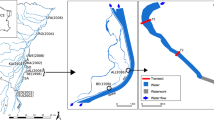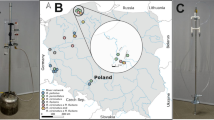Abstract
A novel mechanism of stream development in coastal wetlands was observed in the form of interaction between the burrowing crab (Chasmagnathus granulata) and groundwater seepage. This process may eventually be further promoted by the predatory action of the white croaker fish (Micropogon opercularis). These so-called crab streams occur on the banks of major tidal channels in a salt marsh of the Bahía Blanca Estuary (Argentina). As the tide recedes, water is retained in the crab burrows on the marsh surface. The presence of lateral burrows produced by crab recruits promotes subterranean piping flow driven by the hydraulic head in the vertical burrow. Groundwater generally seeps along the tidal channel banks but is particularly prominent and concentrated where crab burrows perforate the banks. Where predatory attacks by the croaker fish enlarge the burrow mouths, the drainage rills become wider and deeper because more seeping water is collected in the shallow crater from where it is funnelled into the developing streams. The crab stream is then produced by water draining from the crab burrow mouth, acting initially by cut-back erosion and followed by forward erosion of the relatively unconsolidated muddy sediments.




Similar content being viewed by others
References
Aliotta S, Perillo GME (1987) A sand wave field in the entrance to the Bahía Blanca Estuary, Argentina. Mar Geol 76:1–14
Allen JRL (2000) Morphodynamics of Holocene salt marshes: a review sketch from the Atlantic and Southern North sea coasts of Europe. Quat Sci Rev 19:1155–1231
Amos CL (1995) Siliciclastic tidal flats. In: Perillo GME (ed) Geomorphology and sedimentology of estuaries. Elsevier, Amsterdam, pp 273–306
Bortolus A, Iribarne OO (1999) Effects of the burrowing crab Chasmagnathus granulata on a Spartina salt marsh. Mar Ecol Prog Ser 178:78–88
Botto F, Iribarne OO (1999) The effect of the burrowing crab Chasmagnathus granulata on the benthic community of a SW Atlantic coastal lagoon. J Exp Mar Biol Ecol 241:263–284
Botto F, Iribarne OO (2000) Contrasting effects of two burrowing crabs (Chasmagnathus granulata and Uca uruguayensis) on sediment composition and transport in estuarine environments. Estuarine Coast Shelf Sci 51:141–151
Ginsberg SS (1993) Geomorfología y dinámica de canales de marea del estuario de Bahía Blanca. PhD Dissertation. Universidad Nacional del Sur, Bahía Blanca
Ginsberg SS, Perillo GME (1990) Channel bank recession in the Bahía Blanca Estuary, Argentina. J Coast Res 6:999–1010
Gómez EA, Perillo GME (1995) Sediment outcrops underneath shoreface-connected sand ridges, outer Bahía Blanca Estuary, Argentina. Quat S Am Antarct Peninsula 9:27–42
Horton RE (1945) Erosional development of streams and their drainage basins; hydrophysical approach to quantitative morphology. Bull Geol Soc Am 56:275–370
Iribarne OO, Bortolus A, Botto F (1997) Between-habitats differences in burrow characteristics and trophic modes in the southwestern Atlantic burrowing crab Chasmagnathus granulata. Mar Ecol Prog Ser 155:132–145
Kinghton D (1984) Fluvial forms and processes. Edward Arnold, London
Lopez Cazorla AC (2004) Peces. In: Piccolo MC, Hoffmeyer MS (eds) Ecosistema del estuario de Bahía Blanca. Instituto Argentino de Oceanografía, Bahía Blanca, pp 191–201
Melo WD, Schillizzi R, Perillo GME, Piccolo MC (2003) Influencia del área continental pampeana sobre el origen y la morfología del estuario de Bahía Blanca. Rev Asoc Arg Sediment 10:65–72
Perillo GME, Iribarne OO (2003a) New mechanisms studied for creek formation in tidal flats: from crabs to tidal channels. EOS Am Geophys Union Trans 84:1–5
Perillo GME, Iribarne OO (2003b) Processes of tidal channels development in salt and freshwater marshes. Earth Surf Process Landform 28:1473–1482
Perillo GME, Piccolo MC (1999) The Argentina estuaries: a review. In: Perillo GME, Piccolo MC, Pino Quivira M (eds) Estuaries of South America: their geomorphology and dynamics. Springer, Berlin Heidelberg New York, Environmental Science Series, pp 195–216
Perillo GME, Ripley MD, Piccolo MC, Dyer KR (1996) The formation of tidal creeks in a salt marsh: new evidence from the Loyola Bay Salt Marsh, Rio Gallegos Estuary, Argentina. Mangroves Salt Marsh 1:37–46
Perillo GME, Piccolo MC, Parodi E, Freije RH (2000) The Bahía Blanca Estuary, Argentina. In: Seeliger U, Kjerfve B (eds) Coastal marine ecosystems of Latin America. Springer, Berlin Heidelberg New York, Environmental Science Series, pp 205–217
Pestrong R (1972) Tidal-flat sedimentation at Cooley Landing, southwest San Francisco Bay. Sediment Geol 8:251–288
Pethick JS (1969) Drainage in tidal marshes. In: Steers JA (ed) The coastline of England and Wales, 2nd edn. Cambridge University Press, Cambridge, pp 725–730
Pethick JS (1986) An introduction to coastal geomorphology. Edward Arnold, London
Pethick JS (1992) Saltmarsh geomorphology. In: Allen JRL, Pye K (eds) Saltmarshes: morphodynamics, conservation and engineering significance. Cambridge University Press, Cambridge, pp 41–62
Pye K (1992) Saltmarshes on the barrier coastline of North Norfolk, eastern England. In: Allen JRL, Pye K (eds) Saltmarshes: morphodynamics, conservation and engineering significance. Cambridge University Press, Cambridge, pp 148–181
Yapp RH, Johns D, Jones OT (1917) The salt marshes of the Dovey Estuary. Part II. The salt marshes. J Ecol 5:65–103
Acknowledgements
Partial support for this study was provided by the National Geographic Society, CONICET, Agencia Nacional de Promoción Cientifica e Innovación Tecnológica, and Universidad Nacional del Sur. Special thanks are extended to Mr. Alberto Conte, from the crew of the R/V Buen Dia Señor, for pointing out the croaker craters to the authors which initiated the study. We are grateful to Dr. Monique Delafontaine and an anonymous reviewer for the excellent comments and suggestions as well as language polishing which greatly improved this paper.
Author information
Authors and Affiliations
Corresponding author
Rights and permissions
About this article
Cite this article
Perillo, G.M.E., Minkoff, D.R. & Piccolo, M.C. Novel mechanism of stream formation in coastal wetlands by crab–fish–groundwater interaction. Geo-Mar Lett 25, 214–220 (2005). https://doi.org/10.1007/s00367-005-0209-2
Received:
Accepted:
Published:
Issue Date:
DOI: https://doi.org/10.1007/s00367-005-0209-2




